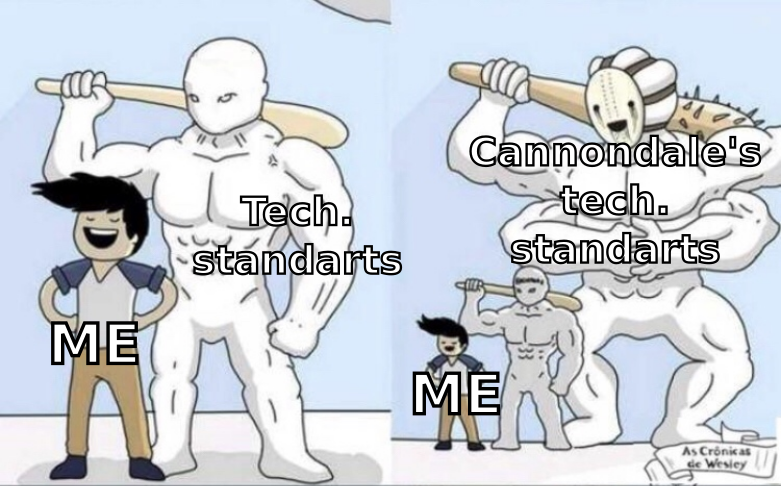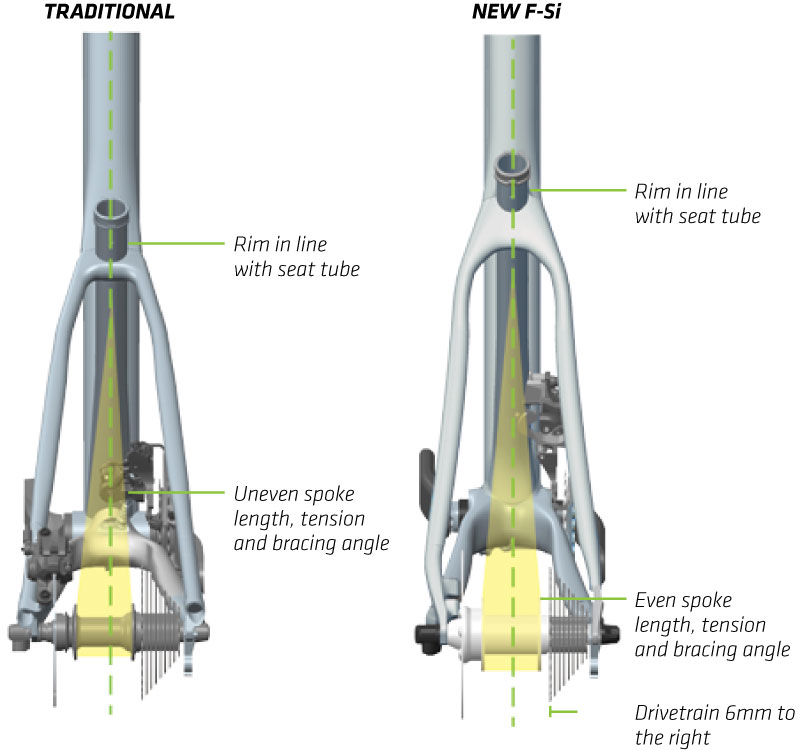on
Cannondale Scalpel HT dreambuild
Hello there! I have finally decided to write a blog post! This story will be about my first hard and expensive project, where I will describe the planning hell, preparing headache and, eventually, building journey of my first carbon XC race bicycle from scratch. I will walk you through all the complexities I met along the way and the knowledge I found that helped me to overcome them. Come and join me if you like exploring and building on your own!
This story will be divided into a series of blog posts, because otherwise it may turn into a book, and I am scared of writing books as for now. This blog post will serve as a prologue that will smoothly start the story and outline the main antagonist. There will be no difficult technical details for now. So, enjoy!
Why Scalpel HT?
 Cannondale Scalpel HT 2022, source: Cannondale
Cannondale Scalpel HT 2022, source: Cannondale
Scalpel HT is a Cannondaile’s mountain bike family that targets XC races and marathons. There is also a brother called just “Scalpel” that features rear suspension. Both are popular modern XC bikes families worth choosing even for top world XC events.
Why Cannondale and Scalpel HT? At the time when I started the project I was not a cycling expert and was not aware of all these world XC championships and all the top brands like BMC, Canyon, Specialized, Trek, SCOTT, Cannondale, etc.. It was a time when I was chasing Bachelor’s degree in engineering in Poland. When you are an abroad student living in a dormitory - you don’t have much freedom in such expensive and technologically-complicated projects. Just check out my room while building the bike:
 Somewhere in Poland, author: Daniil
Somewhere in Poland, author: Daniil
At this time, I prayed no one from the dormitory administration would come and see what hell was going on in my room.
So, the focus during building was not on what I wanted, but on what I needed (well… mostly). What did I need then? The things I considered when choosing the components:
- One time investment.
- Service intervals and service complexity, that defines how much time per, for example, month I will needed to invest into servicing (cleaning, replacing, adjusting, etc.).
- Components durability and components costs, that defines how much money I will invest into the bike per, for example, month (like chain change, etc.).
If the goal was to only minimise things listed above, then it would be better not to buy a bike at all. So there were also a few things that I had to adjust to the costs:
- Performance on track (weight, gears, tyres, etc.).
- Comfort on longer rides (the longest rides for me are around 100 kilometers).
These of course are general definitions, I will cover them in detail in the following chapters.
Getting back to Scalpel HT vs Scalpel. The thing is, that the two most difficult and expensive things to service in every bike (especially the expensive ones) are shocks and bearings. What are the two things full suspension bikes do have that hardtails do not? Right, the rear shock and suspension links that use bearings. Those two components significantly increase all the things I wanted to minimize: the cost and the time needed for servicing.
On the other hand, the rear suspension comes with comfort on longer unpaved rides and better rear stability on technically hard elements. But you know what? Sometimes I deserve those kicks in my ass when I oversleep some bumps on the trail. On the technically complex trails with no rear suspension I really had to get through all those hard downhill and uphill sections on my own legs learning how to handle and how to choose the best way through hell.
Why Cannondale and not any other brand? The answer is simple - at the time Cannondale had the cheapest framesets in Poland.
So, enough of the theory, and let’s get to the real tech and the building fun.
The frame, or where it all began
 Source: https://www.cannondale.com/en-eu/owners-manuals/-/media/files/manual-uploads/my21/021_138678_can_oms%20scalpel%20ht_en.pdf
Source: https://www.cannondale.com/en-eu/owners-manuals/-/media/files/manual-uploads/my21/021_138678_can_oms%20scalpel%20ht_en.pdf
There is nothing special about the frame. It is a classical frame except for the rear triangle, which is said to “eat” some bumps on trails. I am not an expert of bike geometry versus human anatomy, so my choice was based on argumentation logic like “the biggest is the fastest” (mostly because of my height, which is 193 centimeters). Hence I chose the XL size (the biggest available). The exact numbers can be found in the Scalpel HT owners manual.
What I was interested in were the numbers that define what components should be installed:
- Fork:
- Tapered or not tapered: tapered.
- Head tube diameters:
- Upper: 11/8in.
- Lower: 11/2in.
- Maximum fork length: 530 mm..
- Headset type: Integrated 1 1/8in-1.5in FSA Orbit C-40 ACB.
- Bottom bracket: 83 mm. PF30.
- Seatpost:
- Diameter: 27.2 mm..
- Minimal insert length: 100 mm..
- Rear axle: Speed Release UDH/148x12x1.0P 173.5mm OL.
- Tyre size: 29 x 2.35in.
- Brake mount:
- Type: post mount.
- Disk brake sizes: 160/180 mm..
These numbers and letters will be very important when choosing the components.
I will explain the, for example, Integrated 1 1/8in-1.5in FSA Orbit C-40 ACB
and other magic numbers later.
For other details like maximum rider weight or any frame-specific details that are not important here, check the Scalpel HT owners manual.
Cannondale’s Asymmetric integration

Among other things I had problems during researching, the Cannondale’s Asymmetric integration (I will call it Ai in this blog post) is the scariest. Why? Because it changes everything in your bike build, and most exactly: the wheels and transmission configuration.
What is Cannondale’s Asymmetric Integration and why was it invented?
 Source: https://support.cannondale.com/hc/en-us/articles/219101107-Ai-Asymmetric-Integration
Source: https://support.cannondale.com/hc/en-us/articles/219101107-Ai-Asymmetric-Integration
In short, the main reason for it to be invented - is to strengthen the rear wheel structure, by decreasing the difference between right and left rear wheel spokes length. Though, it will not make the spokes on two sides perfectly the same length, that would distribute the stress applied to the spokes equally, because the spokes length difference depends on rear hub implementation-specific parameters, it will significantly reduce the difference and increase rear wheel stiffness. It was the first time I applied my school knowledge about geometry in practice. So there will be some interesting things to discuss later, when building the wheels.
While generally the idea makes sense and definitely has its benefits, it comes with downsides: the cassette should be shifted 6 mm. to the right. Shifting the cassette changes the chainline, which results in a need to correct it on the chainring side, which should be shifted 6 mm to the right too. While the shift for the cassette is not problematic, it just moves. To adjust the chainline on the chainring side you have to play with the crankset and, probably, with the bottom bracket. This comes with a lot of complications, especially taking into account the “Cannondale’s standarts”.
In a few words: there are one or two possible combinations of bottom bracket and crankset that are suitable for Cannondale’s Ai and will match the new chainline. And as I will explain later in the blogpost related to transmission, buying specifically designed components from a specific manufacturer can result in buying the entire transmission from these manufacturers. This comes with significantly greater costs, sometimes lower performance and potential problems with servicing and replacement in future.
I did not want to bind myself to any specific technology and components, and wanted full freedom in customization. Hence, I should have checked whether my frame has this technology, and if yes - how to omit all these proprietary transmission standards. Finding the answer to these questions was a real headache back then.
Why a headache? Because the bicycle world is not very standardized. The top-tier bikes are overloaded with proprietary designs no one wants to share any numbers about and all these “scetchy” marketing words. Consider for example one of Cannondale’s Scalpel frame description:
Scalpel LAB71, Series 0 Carbon construction, 120mm travel, Proportional Response Suspension and Geometry, FlexPivot Chainstay, full internal cable routing, 73mm BSA, 1.5” headtube with 1-1/8” upper reducer/internal cable guide, 148x12mm thru axle, 55mm chainline, UDH, post-mount disc – 160mm native.
Even now I am not sure what some of these words mean and how they affect the, for example, transmission set up.
How did I figure out whether my frame has the Ai or not? First things first,
I checked the mentioned before description of already existing
bikes
on similar frames. And I did not find the words Ai Offset, that means the
frames used in the bikes have the Ai. This was a glimmer of hope that
promised an easier build. But then, while reading forums, I found out that some
of the models of the same family might or might not have the Ai, and there is
no clearly declared condition on that. For example, this might depend on the
year the frame was produced, etc.. Compare for example the description of
this (has the Ai in the description) and this
(doesn’t have the Ai in the description) Scalpels. The only difference seems to
be the chosen language of the site (the Polish or the English language) or used
domain name (.com and .pl)?
Because I bought a frameset, not a bike, and the frameset had no information packed in - my paranoia raised an alarm. The reason: you must be 100% sure about the Ai, unless you want to gamble when buying wheels and transmission that is pretty expensive.
The final conclusion here for me was that my frame does not have the Ai. I have figured out while building wheels and transmission. I will definitely mention it several times in future and will precise things out.
Summing up
So, the story begins with a frame. I think it is a classical beginning for a bike build. The frame defines what fork you are going to use as well as how you want to position yourself on the bike - that is the cockpit. After that come the wheels, as they depend on both: the fork and the frame. And as final step - the transmission, where you will be aligning the frame with the rear wheel.
Therefore, there will be three more blog posts:
- A small dive into forks and cockpits.
- Reinventing the wheel.
- Let it turn!
And that is it for now!
